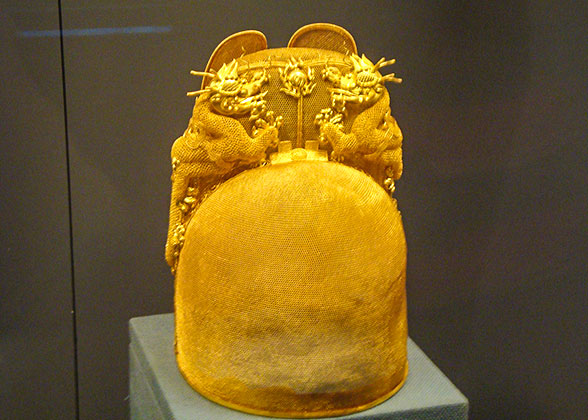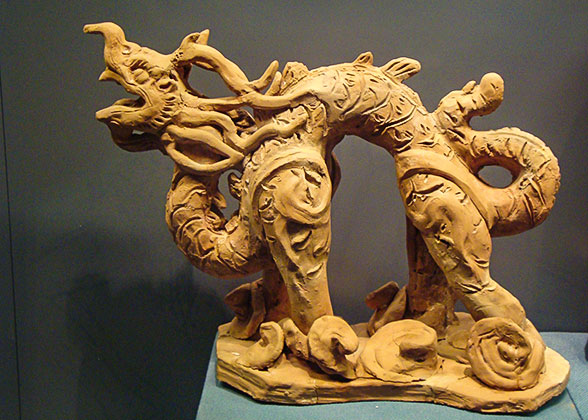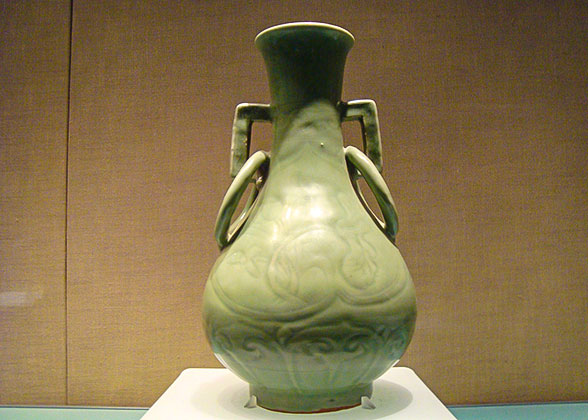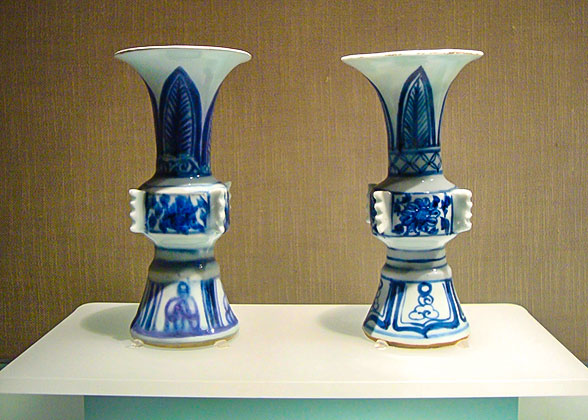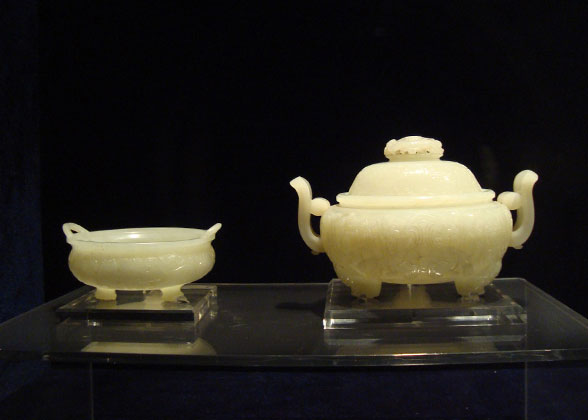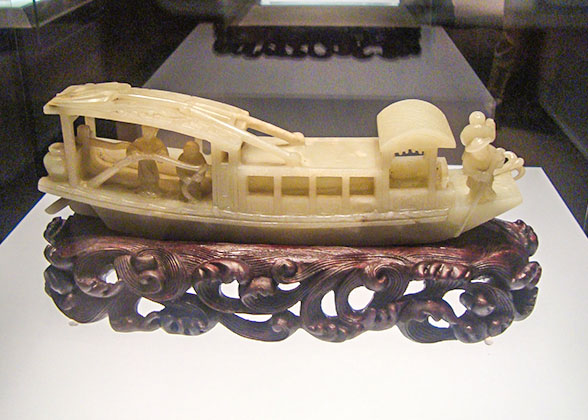Beijing Capital Museum
The address of Beijing Capital Museum is: 16 Fuxingmen Outer Street in the west extension of Chang'an Avenue, in Xicheng District of Beijing City. It covers an area of 29,700 square yards (24,832 square meters) with five floors above ground and two floors underground; its floor area has now reached 75,800 square yards (63,378 square meters). The initial construction started in 1953, and it was formally open to the public in 1981. The Confucian Temple, along the Guozijian Street, was its original site. In order to accommodate a larger collection and a better service to visitors, the new site of Capital Museum was built in December, 2001 and opened on May 18th, 2006.
Collecting, exhibiting cultural relics, and undertaking related research are the three main tasks. Beijing Capital Museum has fully adopted internationally advanced technology in its construction and ranks among the best in China. With imposing building, abundant exhibitions, high technology and advanced services, it has placed itself in the world a leading position. Cultural relics unearthed in this city are its main items on display, which bear forceful features of the city.
Exhibitions
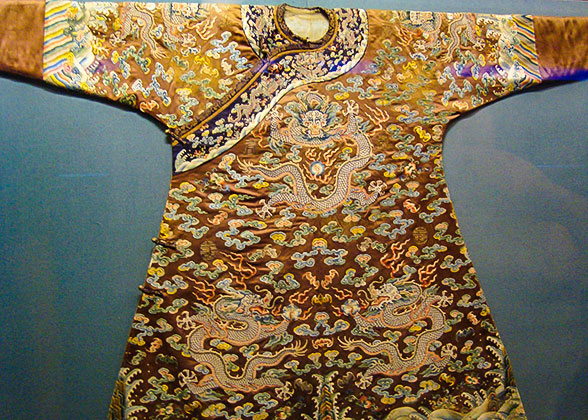 |
| Exhibitions in the Capital Museum |
Beijing Capital Museum stored various kinds of cultural relics extensively over the past decades. Bronze Vessels, porcelain ware, calligraphy works, paintings, coins, jades, seals, needlework, Buddhist statues are in its collection. Some of them enjoy a high reputation both at home and abroad for their rarity.
Most of the collections are those unearthed after 1949. Some cultural relics even date back to the New Stone Age. In total, there are 5,622 pieces of cultural relics on exhibition in the main exhibition hall and in the oval exhibition hall.
Stele of the Emperor Qian Long - Representative Treasure
The Stele of the Emperor Qian Long is a treasure in it. This stele with a height of 22 feet (6.7 meters) and a weight of over 40 ton is constructed of white marble and is well preserved. The Stele of Qian Long is composed by the stele body, two stele caps and two stele bases. The inscription on the stele is in both Manchu and Han languages and in the Kai (regular script) characters. It contains two passages, which share the idea to demonstrate the significance of the capital. These two passages are also the greatest value among the steles of this emperor.
In addition, Beijing Capital Museum has many other valuable cultural relics. Its exhibition can be divided into three parts - the temporary exhibit, the main display, and the fine collection display.
|
|
Temporary Exhibit
Beijing Capital Museum occupies two floors of the main exhibition hall, on the lower ground and ground floors. The items on display are constantly renewed. The culture of Beijing and other places of China and the world may all be the themes of the temporary exhibits.
Main Display
The main display includes exhibitions on history, building construction and folk customs of this city.![]() Exhibition on History (Hall C, the second floor, square exhibition hall)
Exhibition on History (Hall C, the second floor, square exhibition hall)
It form the core of the exhibition and are exhibited in the central display case. They present the development of the city from a remote antiquity to the foundation of New China. Over 675 pieces of cultural relics and a number of diagrams and pictures are on display, including stone implements, porcelain wares, bronzes, gold and silver ware, and many jades.![]() Exhibition on Folk Customs (Hall F, the fifth floor, square exhibition hall)
Exhibition on Folk Customs (Hall F, the fifth floor, square exhibition hall)
Hutongs (lanes) and Siheyuans (Chinese traditional courtyards) are full of local characters, and form the background of the exhibition. The life of people living in the courtyards in Hutong, the folk customs such as weddings, celebrations of a baby's arrival, and of festivals are vividly presented.
Fine Collection Display
It occupies seven exhibition halls in both main and the oval exhibition halls. Porcelain wares, bronzes, calligraphy works, paintings, jades, Buddha statues, exquisite artworks in study room, and folklore of old Beijing are displayed.
A Glimpse of Treasures
Altogether, 262 Tibetan and Han Buddha statues are on display here, most of which are displayed to the public for the first time. You will learn the history of Buddha statues' development and revolution in Tibetan regions and in Han regions![]() Exhibits of porcelain wares (Hall E1, the fourth floor, square exhibition hall)
Exhibits of porcelain wares (Hall E1, the fourth floor, square exhibition hall)
Porcelain wares exhibited here were excavated or handed over when the city served as the capital in the historic period. The exhibition focuses on porcelain wares of Song (960-1279), Yuan (1271-1368), Ming (1368-1644), Qing (1644-1911) dynasties. There are altogether 170 pieces and sets of porcelains. An exquisite blue-and-white globular-shape porcelain vase with under-glazed red and emblazoned with dragon, cloud and wave on display was estimated to be worth ten million in RMB in 2000.
|
|
![]() Exhibits of paintings (Hall H, the second floor, round exhibition hall)
Exhibits of paintings (Hall H, the second floor, round exhibition hall)
Over 50 traditional Chinese paintings are on displayed. Paintings from the Ming and Qing dynasties are central to the exhibition. Famous paintings include the Students of Confucius, the Eighty-seven Gods and the Spring in South China.![]() Exhibits of calligraphy works (Hall I, the third floor, round exhibition hall)
Exhibits of calligraphy works (Hall I, the third floor, round exhibition hall)
Calligraphic works of Yuan, Ming, and Qing dynasties are on display. They can be divided into two categories, works of the famous calligraphy artists and those of royal family members. In total, 53 pieces and sets of calligraphy work are exhibited including inscriptions of the ode to the god of Luo River by Wang Xianzhi in Kai (regular script) character in Jin Dynasty, the calligraphy works of poems of plum blossom by Huang Tingjian in cursive writing in Song Dynasty, the Emperor Kangxi's and of Qianlong's calligraphic works.![]() Exhibits of bronzes (Hall J, the fourth floor, round exhibition hall)
Exhibits of bronzes (Hall J, the fourth floor, round exhibition hall)
Altogether, 132 pieces and sets of bronzes are on display; these can be divided into two groups according to their historical periods (the Western Zhou Dynasty (11th century BC - 771 BC) or Eastern Zhou Dynasty (770BC-221BC)) they belong to. This exhibition demonstrates the delicate craftsmanship and the long history of the bronzesof the culture.
A square castle is in the center of the bronze exhibition hall. Bronzes of the Western Zhou Dynasty are put in the display cases within the inner and the outside faces of the castle wall, while bronzes of the Eastern Zhou Dynasty are displayed by the wall of the exhibition hall. Exhibits of the two dynasties include weapons, ritual vessels, musical vessels, and other vessels. Thus, the differences between the bronzes of the two dynasties can be seen.![]() Exhibits of jades (Hall K, the fifth floor, round exhibition hall)
Exhibits of jades (Hall K, the fifth floor, round exhibition hall)
Over 180 pieces of jades show the jade's brief development. Many items of jades on display were unearthed from the noblemen's graves, and with rein-marks and the emperors' poems carved in. Among all the exhibits, the imperial jade seal of Qian Long (the fourth emperor of Qing Dynasty) has drawn the most attention. This white jade seal with circularly carved dragon was made in 1791 for Qian Long's eightieth birthday. It was the emperor's private seal, and used to be stamped on the emperor's many famous calligraphic works and paintings.
|
|
Magnifying glasses provided here help you have a better look at the tiny pieces. The list of the main kinds of jade in ancient China, and sketch maps showing how the jades are used will also help you to better understand the exhibitions.![]() Exquisite artworks in study room (Hall L, the sixth floor, the oval exhibition hall)
Exquisite artworks in study room (Hall L, the sixth floor, the oval exhibition hall)
The writing brush, the ink, the ink stone and the paper are collectively called the Four Treasures of the study. They are the first part of the exquisite artworks in the study room, and are served as the main content of this exhibition. The second part of the exhibits is mainly small objects in the study room such as brush-holders, brush-racks, paperweights, sandalwood burners and seals. The study room furniture is the third part of the exhibits. A total of almost 150 pieces and sets of artworks are displayed here, including the imperial ink stick with the Emperor Qian Long's rein-mark, the Four Famous Ink Stones in China, and the bamboo brush-holder carved with Belvederes in a Landscape in Ming Dynasty.
It with its splendid treasures will provide you great pleasure, and its imposing building, advanced technology, and excellent services will leave a deep impression on you. Except that, the architecture of Capital Museum is full of Chinese chiastic, such as stone carvings on ground, the decorated archway in the hall, and the stone curtain.
How to get to Beijing Capital Museum
Take Subway Line 1 and get off at Muxidi Station. Get out from Exit C1 and walk eastward for five minutes to the north gate.
Bus / Subway Search
| Entrance Fee: | Free of charge, but visitors need to make a reservation online at least one day before the visit. |
| Opening Hours: | Tuesday to Sunday: 09:00 - 17:00; closed on Monday. |
One Day Beijing Tour: Mini group & Private day trips
More Beijing Tours
10 Non Touristy Things to Do in Beijing
12 Popular Beijing Activities to Beat the Summer Heat
